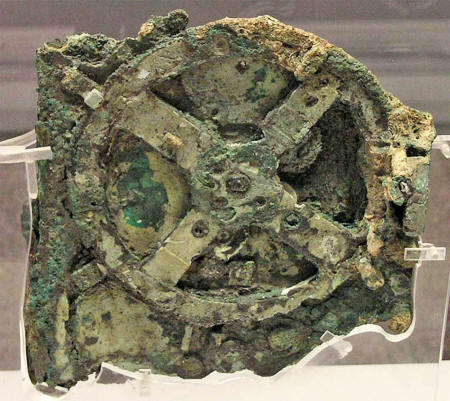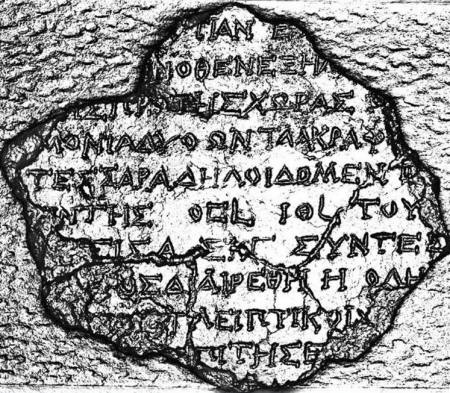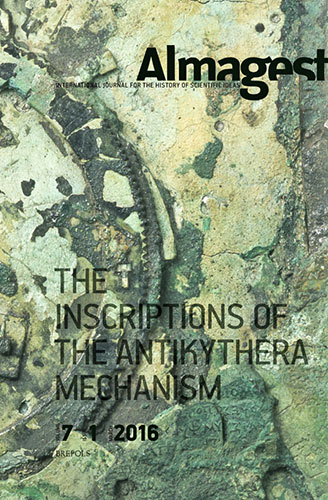The Inscriptions
of the Antikythera Mechanism
Table of Contents and Abstracts
Almagest 7-1, May
2016
1. General Preface to the
Publication of the Inscriptions
M. Allen, W.
Ambrisco, M. Anastasiou, D. Bate, Y. Bitsakis, A.
Crawley, M.G.Edmunds, D. Gelb, R. Hadland, P.
Hockley, A. Jones , T. Malzbender, H. Mangou, X.
Moussas, A. Ramsey , J.H. Seiradakis, J. M. Steele,
A.Tselikas, M. Zafeiropoulou
This is the prefatory paper to a series which
presents the surviving text inscriptions on the
Antikythera Mechanism.
The structure of the
mechanism and the history of the reading of the
inscriptions are briefly reviewed.
The methods used by the
Antikythera Mechanism Research Project to image the
inscriptions - computed tomography and
polynomial textual mapping - are outlined.
The layout of the
inscriptions is described, and the dimensions of the
mechanism deduced to allow the space available for
inscriptions to be estimated.
General conventions and
notations are provided for the presentation of the
inscriptions.
2. Historical Background
and General Observations
A. Jones
This paper presents a detailed account of the
history of the fragments of the Antikythera
Mechanism preserved in the National Archeological
Museum, Athens, with particular attention to
previous transcriptions and paleographical
appraisals of the inscriptions in the fragments.
The paper concludes with
general observations about the technique and
paleography of the inscriptions.
3. The Front Dial and
Parapegma Inscriptions
Y. Bitsakis,
A. Jones
The dial at the center of the front face of the
Antikythera Mechanism was surrounded by two scales,
one representing the zodiac, the other the Egyptian
calendar year.
The Zodiac Scale was
inscribed with the names of the zodiacal signs as
well as series of index letters in alphabetic order,
while the Egyptian Calendar Scale was inscribed with
the Greek names of the Egyptian months.
In addition, two
rectangular plates, the remains of which survived
displaced from their original positions, bore an
inscription, called the Parapegma Inscription,
comprising an alphabetically indexed list of
annually repeating astronomical events relating to
the Sun and to fixed stars.
This paper gives
transcriptions and translations of the inscriptions
on the dial scales and the Parapegma Inscription,
and deduces the original structure, layout, and
location of the Parapegma Inscription.
A provisional
astronomical analysis of the data in the Parapegma
Inscription and tentative restorations of some of
its damaged and missing lines are also provided.
4. The Back Dial and Back
Plate Inscriptions
M. Anastasiou,
Y. Bitsakis, A. Jones , J. M. Steele, M.
Zafeiropoulou
The rear face of the Mechanism consisted of a
rectangular "Back Plate" dominated by two large
spiral dials.
The upper five-turn
Metonic Dial represented a 235-lunar-month
calendrical cycle while the lower four-turn Saros
Dial represented a 223-lunar-month eclipse
prediction cycle.
A subsidiary quadrant
"Games" dial was situated inside the Metonic Dial,
and a subsidiary three-sector Exeligmos Dial inside
the Saros Dial.
Preserved text inscribed
around the dials (from the lower right quarter of
the plate), probably representing about a quarter of
the original inscription, provided further
information associated with the predictions of
eclipses.
This paper describes the
reconstruction from the Mechanism's fragments of the
surviving parts of the text on the plate and its
dials, giving transcriptions and translations.
The Metonic Dial
inscriptions imply a calendrical scheme similar to
that described by Geminos. It was intended to be a
version of the calendar of Corinth as it was
practiced either at Corinth itself or in some
locality of Epirus.
The Games dial shows six
competitions, four Panhellenic (Olympics, Pythian,
Isthmian, and Nemean) plus Naa (Dodona) and very
probably Halieia (Rhodes).
On the Saros dial there
were probably originally about 50 or 51 month cells
with a lunar and/or solar eclipse prediction, each
carrying a "glyph" and an index letter.
Predicted eclipse times
(in equinoctial hours) on the glyphs were calculated
as times of true syzygy according to solar and lunar
models that both involved anomaly, with the simple
Exeligmos dial extending the predictions over three
or more Saros cycles.
We are reluctant to base
a firm construction date on interpretation of the
eclipse cycles.
The additional
information referred to by index letters from the
Saros dial was grouped into paragraphs; that for
lunar eclipse prediction probably ran down one side
of the plate, and that for solar eclipse prediction
down the other.
Statements about
direction may imply a meteorological aspect by
referring to predictions of winds attending the
eclipses.
Five references to color
and size at eclipse are the only Greco-Roman source
known to us that suggests prediction of eclipse
colors, and might conceivably be linked with
astrology.
5. The Back Cover
Inscription
Y. Bitsakis,
A. Jones
This paper presents an edition with translation and
commentary of an extended text that was inscribed on
a plate (or conceivably a pair of plates) that lay
against the rear face of the Antikythera Mechanism
while it was under the sea.
This plate, which may
have functioned as a protective cover, is extant
only in small fragments, but more of its text was
preserved as offsets on a layer of accreted matter
that built up against it.
The text was a
systematic description of the dials, pointers, and
other external features of the Mechanism, beginning
with the front face and continuing with the rear
face.
The best preserved
passages include descriptions of features on lost
parts of the Mechanism: a display of pointers
bearing small spheres representing the Sun and
planets on the front dial, and a dial on the upper
back face representing a 76-year "Kallippic"
calendrical cycle.
6. The Front Cover
Inscription
M. Anastasiou,
Y. Bitsakis, A. Jones , X. Moussas, A.Tselikas, M.
Zafeiropoulou
The bronze plate known as the "Front Cover" of the
Antikythera Mechanism had inscriptions on its
outside face.
This paper describes the
reconstruction of the surviving parts of this text
from the Mechanism's fragments, giving
transcriptions and translations.
The texts give data on
synodic cycles for the five planets, and it may be
conjectured that lost lines described the behavior
of the Sun and Moon.
The data strongly
support the idea that planetary motions were
displayed on the front face of the Mechanism using
simple epicyclic or eccentric models.
Previously unattested
long and accurate period relations are given for
Venus and Saturn, which are favorable for geared
representation and probably of Greek, rather than
Babylonian, origin.




